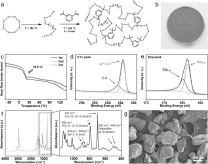
The solid-electrolyte-interface (SEI) layer plays a key role in lithium ion batteries, obstructing undesirable electrolyte decomposition by selective lithium ion transport into the active electrode materials. However, lithium metal anodes (LMAs) suffer from infinite volume expansion during metal deposition/stripping cycles, where the typical 2D SEI layers have a limitation in covering three-dimensionally growing lithium metal. In this study, 3D-structured organic-inorganic hybrid SEI (3D-hyb-SEI) layers were prepared using a sulfur copolymer (SCP)- poly(sulfur-random-1,3-diisopropenylbenzene) (poly (S-r-DIB)), and carbon black (CB) mixtures. Sulfur atoms of poly(S-r-DIB) form inorganic Li2S by conversion reactions with lithium ions, and the remaining DIB molecules react with the electrolyte to form organic SEI compounds. The 3D-hyb-SEI layers guide stable and durable lithium metal deposition/dissolution cycles by protecting the 3D-structured LMA, as evident from the significantly stable and long-term cycle life over 1,000 cycles, with an average Coulombic efficiency value of ~99.0%. The practicability of the 3D-hyb-SEI layers was demonstrated by a full-cell test with a commercial NCM622 cathode, whereby high energy and power densities of ~540 Wh kgelectrode−1 and ~2,840 W kgelecrode−1, respectively, were achieved with high cycling stability.
